

Ai Weiwei (Beijing) is an artist, curator, and architectural designer who has been working in China and the United States since the late 1970's. An original member of "Stars," a group of artists working in Beijing in the late 1970's during the first years of reform, Ai attended film school with directors Chen Kaige and Zhang Yimou. He then traveled to the United States where he made conceptual art focused on the alteration of readymade objects and situations. In the early 1990's Ai returned to China to edit a series of three books on the art a new generation of artists, based in Beijing's Eastern Art Village: "Black Paper," "White Paper," and "Gray Paper." Since that time he has produced work which focuses on China's cultural history, centralized political system, and the contradictions of modernity. His work has shown across Europe, North America, and China.
Ai uses a set of tactics for the production of his work: undermining the meaning of existing artifacts, attacking fixed hierarchies of power, privileging developed vernacular knowledge and simply letting things take their own course. Over the past few years he has moved closer to architecture, beginning with the design of his own studio, the China Art Archives and Warehouse, and the Urs Meile Gallery all in the outskirts of Beijing; the plan for a Park of architectural follies in his family's home town of Jinhua in Zhejiang Province; and a collaboration with Herzog & de Meuron Architects on the Beijing Olympic Stadium.
This interview by Adrian Blackwell took place on June 21, 2006 at Ai Weiwei's studio/home in Cao Chang Di Village on the outskirts of Beijing.
Adrian Blackwell : There are two things we are interested in with your urban work. The first concerns your thoughts about the contemporary city: what's happening right now with Chinese urbanization? The second is the approach you take in your own urban interventions. I thought we could begin by talking about some of your recent projects. You started making art in the late 1970's, architecture in the late 1990's, and then quite recently, just a few years ago, you began to making works that are about urban space, documents of your city. I know of four of them: the Beijing video map, the void photographs, the Chang'an boulevard project and the Ring Road project. They are each fascinating ways of reading Beijing. What made you start making work like that, what made you start documenting the city?
Ai Weiwei : It's not exactly documenting. It has that function, but it has no documentary purpose. It's not being used as evidence or testimony for anything, but rather to materialize our physical life, its condition in the moment. If you are in place A or on line A or line B, then that present there or that movement is simply as it is. We're living in a constantly changing world and everybody sees it and knows it, but as an artist who is also involved in issues of design and urban planning, I always try to find a way to most efficiently capture what I call fragments, or very small pieces which carry the flavor or carry the essential meaning of the city. So it's a very small effort that I have made, even if it looks quite massive in terms of the length of the videos, its just one section of a fact - the concrete world.
AB : So maybe we could talk briefly about each of those pieces. Let's start with the first piece, the video which follows every street in Beijing within the fourth ring road.
AW : "INTERVAL" - From Da Bei Yao to Da Bei Yao, 8.10. - 7.11.2003.
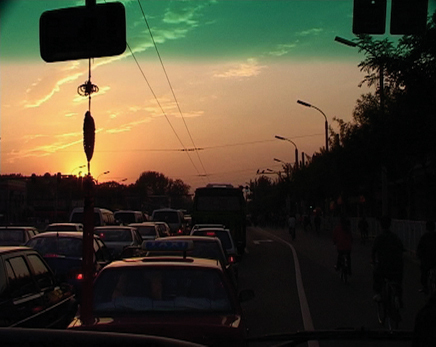

Stills from the video: "INTERVAL" - From Da Bei Yao to Da Bei Yao, 8.10. - 7.11.2003 .
AB : It's about the street network and it makes me think of Zhu Jianfei's book Chinese Spatial Strategies . He talks about the public space of the city of Beijing arguing that in a western city you have squares, public space is organized around openings in the fabric, while in the Chinese city (his example is Ming and Qing dynasty Beijing) public space is in the street, so the public space is not a void, but a network of space, and the active spaces are simply nodes, or widenings in that network. One of the things that I like about this project is that it is an attempt to map this entire network using video, but it also conflates the map and its opposite, which is the experience of simply being lost in the city. What were you thinking about with this network of every street in Beijing?
AW : I think that a city is a three dimensional or multi-dimensional thing, but the work itself is not even two-dimensional, it's just one point to another, to another, to another. So of course in time this weaves a net if you are thinking of the road you have been traveling along or if you join the individual points. It covers the whole city, all the hutongs and streets, but actually it is made at one time, at a moment. Still it follows a line, a line made by a vehicle which has more than a dozen people on it, and from day 1 to day 16 it passes through different parts of the city. So it appears to be a complete view of Beijing, but if you look at any point, it's just dots, because there is no camera movement except the movement of the car. Very little changes, but the attitude or position that drives it is not passive, it's fixed through a very concrete concept. So I think it's quite ironic in that sense: after 150 hours it documents the city, but nobody would watch 150 hours and at any moment you see, you are confined to a single point, or proportionally stretched points form a very short time within this big work. It only works when it is so long, more than six days and nights. It shows how big, how impossible, how crazy this city is, or how meaningless at the same time, because our proportion, our sense of time, and also our visual contact with the city is really limited by where we are and which direction we go. The moment is about a certain period of time, so when you just look at one moment you don't really know what is before or what is next, even if you can pretty much guess.
Images from the urban void series.
AB : With the void photographs you are documenting a moment where there is nothing. If you think about Chinese cities as constantly being torn down and rebuilt, then this is a moment of quiet in between. It seems that this is a moment of potential, but I don't know if you are that optimistic about this possibility all the time. What made you take those photographs?
AW : I think that's a special landscape in today's China, you are the largest construction site in the world and each year Beijing has one hundred million square metres of construction which exactly equals the area of the whole city in 1949. Every year you have this total amount of construction, but you only finish a third of it, thirty million square metres. You know these are just numbers, but they really tell you something about the urban condition, especially when you see that China builds 20 times the area built in Beijing. The whole country is building crazily. So you have a kind of landscape that destroys the old, because the old is really garbage I think. It's really shelter in its worst condition, like Harlem. We used to say that Harlem was 100 times better than most ordinary people's houses. Then after you destroy you make it flat - we call this san tong yi ping (three [infrastructural]connections and one leveling).
Images from the urban void series.
Pei Zhao : By now its jiu tong yi ping (nine connections and one leveling)
AW : Then all this land will be rebuilt by powerful people, developers. Most of them, are connected to the government. They make big profits from land, which is not constitutional. After 1949 land was taken from the landlords. They killed the landlords, and the land was given to the people, under the control of the state. Now all the land is being auctioned to people in favor or associated with the state, who are profiting from their privileged background. So you have a landscape that is just waiting for this future. Even if it's totally empty, it will soon be built. Soon it will change the whole landscape of Beijing and of China.
It's a very sad condition, you see a nation or a city rip up the past, not to benefit the people, or the situation, but for profit, it's really the idea of all those new rich. It's like a country girl has to be a prostitute, because there is no other way to get out of the village. China's development is so much based in this idea: to let somebody ruthlessly become rich, but they can't become rich unless the party and government also profits, otherwise it's impossible. So who has become rich? Who has become more powerful? Who benefits and who is losing their rights, or their property. This property belongs to everybody, it belongs to somebody who never sees this property, because you know we are a communist country and this of course for the past 10 to 20 years has been a hidden secret (I mean nobody talks about it). It's stealing. I am not criticizing, these are only the facts. I record the condition after things are torn down and before they are built up, you know it's a very short moment, but in that moment nobody wants to look. There's a question mark there, a big, big void. The old is so sad, but the new is also sad. It is a very sad condition, so I think it's interesting to record it. It's a unique situation, a void with many questions, yet people don't want to look, or raise these questions.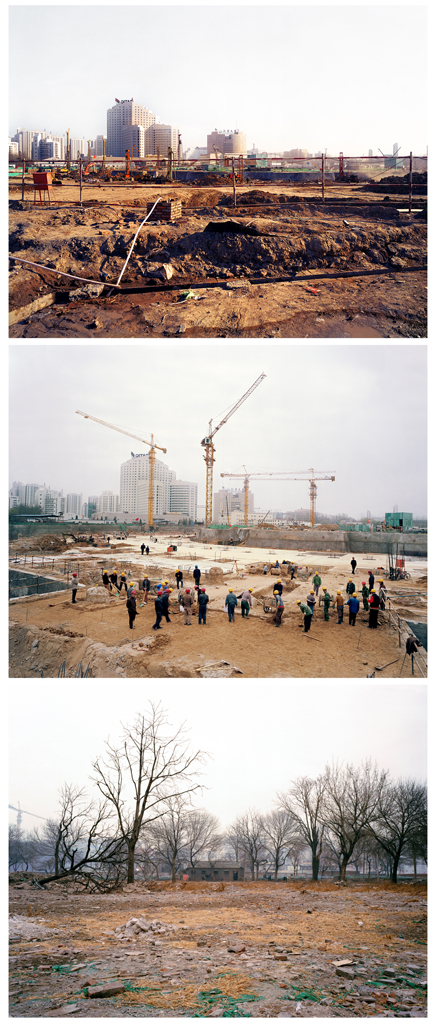
Images from the urban void series.
AB : If the void project looks at empty moments inside the city, the Chang'an boulevard project moves in a straight line from outside through the city. It's a section. You were interested in the movement from rural space through urban space and back to the rural. How do you see that piece describing the contemporary city?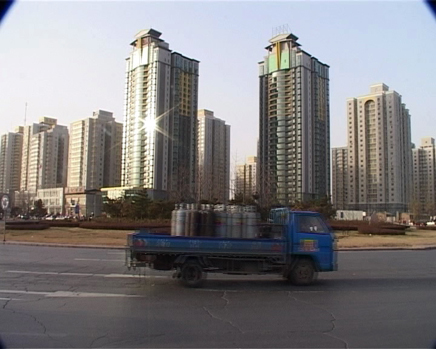
Stills from the video of Chang'an Boulevard.
AW : I think that surprisingly enough when I started to make it, I did not know what it would be. It's not based on very sophisticated thinking, more on an attitude than on careful planning. It started when one of our friends said they had a son who wanted to come to Beijing, but had nothing to do. After he arrived I asked him if he could do this for a while. Then after days of planning what he should do, I found that Chang'an from the 6th ring road to the 6th ring is 45 km. So I made a very simple decision: just take one video shot for one minute every 50m. No technical requirements: push down, count 1 minute, turn it off, move another 50m, push down... Whatever happens in front of the lens is fine. It took months, the whole winter, because in the winter there is no better or worse view. I think in Beijing the winter really reflects northern landscape very well. You know there is a kind of sadness there. So after months he had taken 1000's of shots: from a very rural, primitive village, to the business district, to the political center, to an old town and later on ended up in the Capital Iron Company, which has just been destroyed and moved to another city township. This video was the last possible time to take these shots of the Capital Iron Company, a symbol of socialist industry. They made all the iron for the nation.
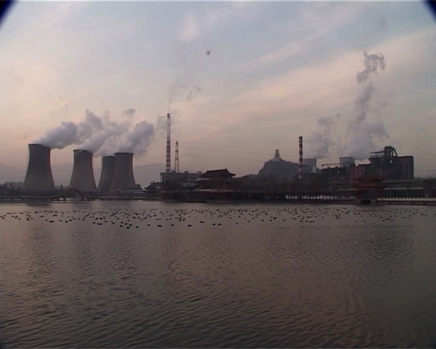
Stills from the video of Chang'an Boulevard.
AB : When you look at maps of the growth of Beijing from 1949 to the present it is amazing to watch Chang'an Boulevard, it draws the city out, away from the old city. So much of the growth of the city is along that line that it is much longer than the rest of the city. The Last work that I know about that deals with the city is your Ring Road project.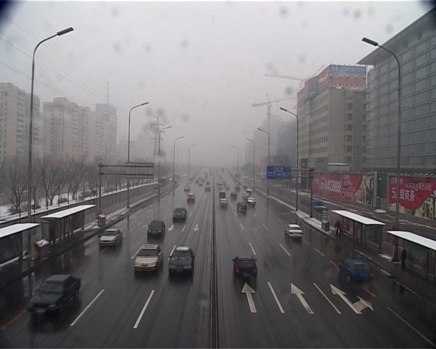
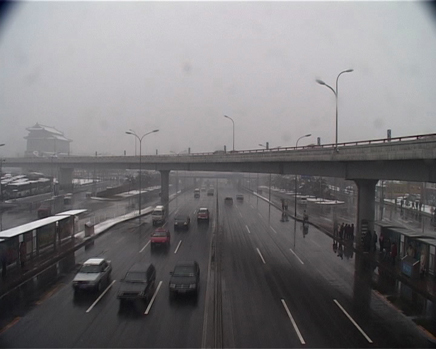
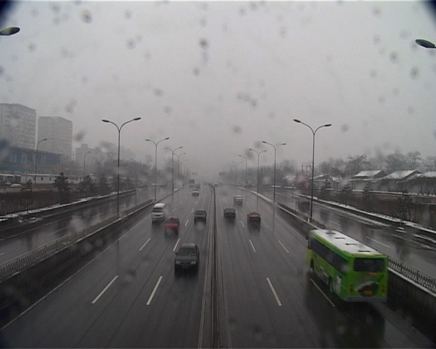
Stills from the video of the second ring road.
AW : I made two pieces, one about the second ring and the other about the third ring. The video of the second ring is structured through the 33 bridges, taking one minute shots on each side of the bridge. So standing there you see the car traffic moving from overhead. Then I did the third ring, 50 some bridges and the same thing, the only difference is that second ring is taken on cloudy days (in Beijing most days are like that), while the third ring is taken on sunny days. If you look at it immediately you know that one's second ring and one is third ring. One is just grey color, and sometimes snowing. It's very boring and not an exciting thing to do, but nevertheless it records the condition at the time, its very much like a witness passing through: what he would see, his eye, anybody's eye. There is no artistic or aesthetic value, not much judgment there. Its very, very simple situation; it's very much like a monitor actually.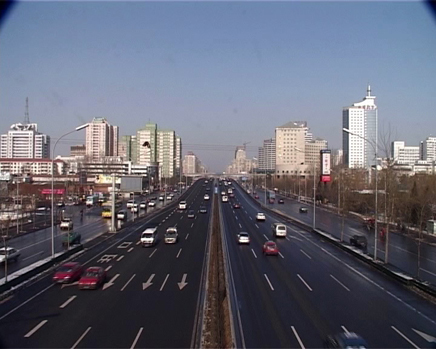
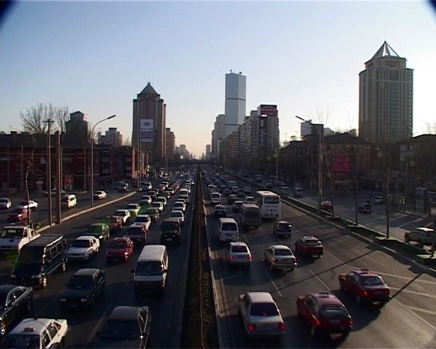

Stills from the video of the third ring road.
AB : We have talked a little bit about these works you have done about the city. But the other thing I am interested in is the way you live in the city. You live in a village; you don't really live in the city.
AW : Well this city, Beijing, surprisingly enough is not a real city. I cannot call it a city, it's still very flat, not dense enough, not strong enough, it doesn't have enough variation and mixed conditions, it's still very even.
Today I live in Beijing. I was also born in Beijing, but soon after we moved to Xinjiang and I grew up there. My father owned a courtyard in Beijing, but for years other people lived in it, because our family was considered an enemy of the people, an enemy of the state, and an enemy of the party. Three enemies. Being just one of them was enough to be exiled. Then after 20 years away we returned and lived in different parts of the city. We borrowed places, because our home was inhabited by other people. We lived in different places: West, North, East or South, so I have a very clear image of what the city looked like. At the time the city was occupied by bureaucratic compounds: universities (of course at that time were not open), government, military and so-called scientific research institutes. All these different departments were all under the same conditions, communist, without private property, everyone belonging to the work unit. So there was only one condition: you were either one of the people or an "enemy of the people." So simple. I guess there weren't so many "enemies of the people," but from time to time that vein was very consciously mined. They were trying to find out who is an enemy of the people for years while I was growing up. It was one political movement after another after another. It was crazy every day. Today you talk about it and it sounds more like a joke: "what a joke, why are you still talking about things like this?" But this was true: many people lost their lives. I think that that ghost is still haunting China today. Not the communist ideology, the ideology may be good, but the way that this power is maintained within society and how brutal the state can be towards a human's basic condition, not to talk about human rights, but essential needs.
So that is basically what this city was and still half of the city is still based in this and the other half is the so-called new rich, after Deng Xiaoping's getting rich first policy. Of course who is going to get rich? It's not the ordinary person. But this is not a complaint, it's simply the truth. You know in China, you still talk about people who have the right to live in the city or not to live in the city. It's called hukou , dividing people into locals, non-locals.
PZ : You need a license, or special registration to live in the city. Throughout the entire world only North Korea and China have a policy like this one.
AW : Locals don't have many rights, besides the privilege of enrolling in school, but in the newspaper they often talk about the crimes caused by non-locals. There is a crazy amount of discrimination against people who are not local. A small example of this is that the city has laws against illegal structures like this one (Ai Weiwei's home and studio). Think about it this way: the city is built solely by migrants from the outside, but none of them are locals except the boss and where are they going to live? Nobody provides any space for them. Of course they gather at the outskirts of the city...
PZ : And in the village in the city...
AW : Just to build a place that they can stay, whether it's legal or not.
AB : But this village, Cao Chang Di, is it a village that pre-dates the city, or is it a village like you are talking about now, a village that is built illegally? Most people that live here appear to be migrants, but did they build this village, or did they inhabit an existing one?
AW : In the 1960's this was a so-called "China Albania Friendship Farmer's village." These were very privileged farmers, who were supposed to provide an example for the country, growing vegetables for the city.
So when university or high school students graduated, and Chairman Mao sent them to be re-educated on a farm, they would send some people here. At that time people working here found much better conditions that you would find in more distant areas. At least on the weekend they could ride their bicycle home. These were example farmers, so it was a good farm.
Recently I heard that it is no longer a village and the former farmers are buying out their hukou to become citizens, instead of farmers. The real reason this is happening is so that the land can be returned to the government, because if you are a farmer no one can take your land. Of course there is real benefit for these new citizens, they have some new citizen's rights, but at the same time the land is returned to the state, so that it can sell the land to anybody it wants to. There are a lot of tricks and games, but it is really so simple: the state is the only beneficiary. But in a state, like China, which is not a democratic society, far from it, nobody argues about this, the press won't talk about it, intellectuals never discuss it. Probably I am the only crazy guy who always talks about it. But they think: "This shit guy, why is he always talking about this?"
So what kind of city is this? I can't see a city without citizens. It's like you don't see a religion without followers. Nobody can decide how the city is going to be; everything is done through governmental decisions, today we need a road here, tomorrow... It's by very simple decisions from the top. If Sanlitun (a Beijing bar street) becomes nice they say: "Oh, lets change it, we'll plan big buildings so that someone can profit from it, not all you street vendors." It's crazy, whenever they see people benefit, they will grab the profit. It's so simple, they change here or there not as they say, to make the city better. The city is already better when they do nothing, take 798 (a contemporary arts district, in a former model industrial work unit) as an example, but once they see this they always take action.
So that's my understanding of this city. I really have no relationship with it, except when journalists come to visit me. Otherwise I just go to one restaurant, which I designed (called Where to Go? ). A lot of friends go as well, so we have a place to meet and eat dinner, and then I come back here.
Where to Go? , a restaurant designed by Ai Weiwei in Beijing.
AB : This is a courtyard house, and it seems to me that the kind of city you are talking about when you say you live here and in your restaurant, has very few elements, its not so much about the city space in between. I am interested in that because a lot of people, for instance New Urbanists in North America, might say you make a good city by making lively streets, by concentrating energy on the public space of the city. I don't know if it is the way you would like to make a city, but the way you live is different from that, its much more about autonomy, creating a separate space through the compound, but still finding forms of community. The restaurant for instance is a kind of public space, which can't be here in Cao Chang Di; it's better that it's in the city, because people can get to it more easily. I am wondering if you are interested in making a city that starts from the way you live in it, which I think is quite different from the way many others think a city should work.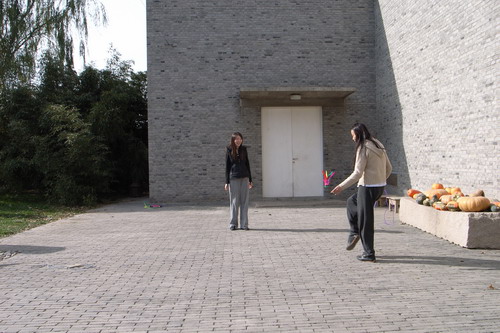 Ai Weiwei's courtyard home.
Ai Weiwei's courtyard home.
AW : Of course most European cities are based in convenience and efficiency. But it's not necessary to me that these functional requirements are supported, what is more important is the use. You need a real variety of intention and purpose: people who are doing things that you would never think about. So you know that's important. I think a city can be very brutal and lacking in qualities of life, because these are not desired, but without many different purposes, the city loses its initial reason for becoming a city.
Many places, like this city, have vast areas without use. It is so strange, these spaces are not for individuals; they're for a special group that has no meaning. This group gives the city no meaning; it's a negative force, working against other people.
AB : Maybe we could finish, with a question about the different processes you use in making art. I'll list some of the different techniques, or tactics, that you use. I am interested in how you might see them applying to your design thinking and its relationship to processes of urbanization.
The first is the notion of detournment, this Situationist idea of diverting the meaning of existing artifacts, taking found things and altering them slightly to change their purpose. You've used this technique in architecture, in the projects you did at Beijing's Soho housing development, the silo and the upside down house, and in the project we're sitting in - your own studio. Even though it's not a found object, it looks like one. You use ordinary typologies and vernacular forms and slightly modify them.
The second involves letting things go, you just drop a Han Dynasty vase on the ground. You let it go to see what happens. I think this works like the video pieces as well, you set up a process to see what ensues.
But then there is another tactic you use: an overt "fuck you!", working very strongly against authority, centrality...
AW : ...order and the state, establishment... Documenta 12 in Kassel, Germany.
AB : And I guess the final one which is in some ways the opposite of the last one, is that you use the power of developed knowledge, a general intellect, vernacular techniques, you have a deep respect for the way people do and make things.
So I am wondering how you see these tactics in relation to the city, can you see your practice of making urban space in relation to these same techniques? carving wood
carving wood
AW : I think we are in a very special moment, As Chinese people, but also internationally, we have gone from the cold war, an unjust society, towards so-called globalization, or a stronger capitalist society, or an information age. Everything happened with a purpose leaving us with unknown conditions. I don't think humans can ever really control this, and it has become even less controllable. Circumstances are now much more complicated than we can predict. For example until quite recently there was no China or India and now suddenly they are the factories of the world. But people are still trying to figure out what this means in relation to ideology, social and political structure, and all kinds of other problems, like education and the environment. I don't think there is a single reaction, at least for myself that can answer these questions, or put me at peace. So I constantly think about the condition of being lost. Once you're lost, you try to figure out where to go. Imagine you're in the middle of a train station and you try to understand the much larger, much more complicated, space around you, or the travel you are embarking on.
So I think it's crazy, the whole thing is crazy. I am not very clear about what I am doing. If I have a character, I don't have much purpose in my life, but more of a natural flow. The only fact is that I am still alive. I'm here. This is solid now, but even this might change. I can't figure out what is going on. Really that's true. Honestly, I don't have a clear answer for this. The clearest answers look ridiculous to me.
Adrian Blackwell teaches architecture and urban design at the University of Toronto's Faculty of Architecture, Landscape and Design.
Pei Zhao practices architecture and urban design with Parsons Brinckerhoff in Beijing.
Together they curated the exhibition Detours: Tactical Approaches to Urbanization in China at the University of Toronto's Eric Arthur Gallery . The exhibition features projects by nine contemporary architects and two artists, including Ai Weiwei's "INTERVAL" - From Da Bei Yao to Da Bei Yao, 8.10. - 7.11.2003 .
Creative Commons License
This work is licensed under a Creative Commons License .
/Creative Commons License
2 Comments
Great interview! When I express similar opinions they see me sort of strange, I am a foreigner after all. Am not supossed to understand things Chinese...Now I will be able to add a local reference for argument's sake after Ai Weiwei. Thnak you.
Victor Ochoa
Beijing
AMAZING! There was a documentary aired about Ai Weiwei on the CBC up here awhile back, it chronicled how he grew up, how his father (a revered poet) had his books burned by officers of the state, and how all these events led him to becoming factious towards the republic. I love his cerebral way of thinking...
I am not very clear about what I am doing. If I have a character, I don't have much purpose in my life, but more of a natural flow. The only fact is that I am still alive. I'm here.
I mean, when you can question yourself, and question your purpose, it leads you to answers that u never knew were possible.
Block this user
Are you sure you want to block this user and hide all related comments throughout the site?
Archinect
This is your first comment on Archinect. Your comment will be visible once approved.